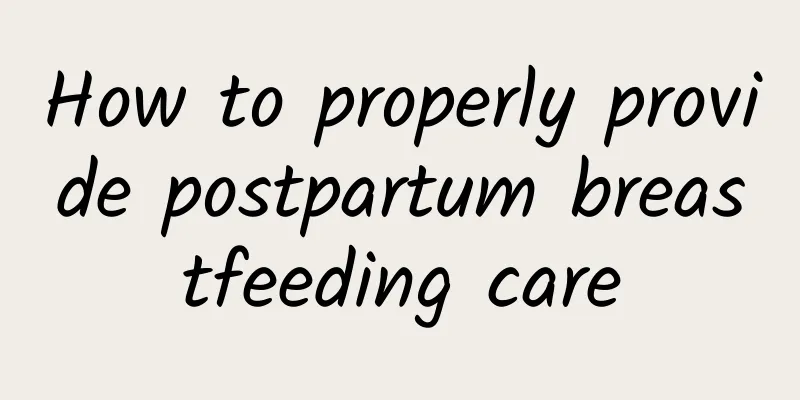How to properly provide postpartum breastfeeding care

|
Breast milk is the most nutritious food that a mother can provide for her baby. It not only helps the baby grow healthily, but also strengthens the bond between mother and baby. Breastfeeding may seem simple, but it actually involves a lot of knowledge. It is very important to master the correct breastfeeding method and to be able to carry out correct postpartum feeding care. Many new mothers are not familiar with breastfeeding. Let us learn about it today. The picture comes from the Internet 1. Benefits of Breastfeeding Breastfeeding is the natural and healthiest way of feeding and is widely recognized as the most ideal food source for newborns. Breastfeeding is beneficial to both mother and baby. 1. Benefits to Babies Breast milk is rich in antibodies and immune factors that can help newborns fight diseases and infections. Breast milk also provides a variety of nutrients that babies need, such as protein, fat, carbohydrates, vitamins and minerals. These nutrients are essential for the growth and development of infants, especially for the development of the brain and vision. 2. Benefits to pregnant women 1. Breastfeeding helps promote uterine contraction and reduce the risk of postpartum hemorrhage. 2. Breastfeeding can help mothers regain their postpartum figure because they consume extra calories during the breastfeeding process. 3. Breastfeeding can also reduce the mother's risk of breast cancer, ovarian cancer and osteoporosis because the mother's hormone levels change during breastfeeding, which helps protect the health of the breasts and bones. 4. Breastfeeding can establish a closer emotional connection between the baby and the mother. During breastfeeding, the mother and baby can have more skin contact and eye contact, which helps to enhance the baby's sense of security and establish a parent-child relationship. 2. Correct postpartum breastfeeding care 1. Start breastfeeding as early as possible The milk secreted by the mother within 5 days after delivery is called colostrum. It is milky yellow, viscous, high in protein and low in fat. It also contains a large amount of secretory immunoglobulin A, vitamins and other nutrients, which are very beneficial to the baby's body. Therefore, breastfeeding is necessary as soon as possible after delivery. If it is a natural delivery, you can try breastfeeding half an hour after delivery. The newborn needs to suck on both breasts for 3 to 5 minutes each to promote milk secretion as soon as possible. If the baby cannot suck, the mother can gently place the nipple near the baby's mouth to guide the baby to suck, help the baby learn the correct sucking action, and establish good breastfeeding habits. (II) Use the correct breastfeeding method 1. Before and after feeding, mothers should wash their nipples and breasts with warm water to keep them clean. At the same time, mothers should avoid using soap or detergent to clean nipples to prevent irritation to the baby's mouth. 2. Choose the right breastfeeding position Mothers can choose the appropriate breastfeeding position according to their comfort and the needs of their babies. When breastfeeding, mothers should keep their bodies relaxed and fully expose their breasts so that the baby can suck easily. Common breastfeeding methods include: cradle position, which is the most common breastfeeding position and is suitable for healthy full-term babies. Mothers can sit upright or half-lying, place the baby on their abdomen, support the baby's head with one hand, and hold the baby's buttocks with the other hand. Cross position, suitable for mothers with large breasts or when the baby has poor latching, mothers can sit upright or half-lying, place the baby's head on their arms, and hold the baby's buttocks with the other side of their arms. This makes it easier for the baby's mouth to align with the nipple, making it easier for the baby to suck. Semi-lying position is suitable for the first breastfeeding after delivery, nipple pain or nipple confusion of the baby. The mother can lie on her side, place the baby next to her body, and support the baby's head with her arm. Side-lying position. This position is suitable for after a cesarean section or when the mother needs to rest. Rugby position and double-sided rugby position are suitable for twin mothers who breastfeed two babies at the same time or when the baby has difficulty latching. The picture comes from the Internet 3. Master the correct sucking technique The baby's sucking action should be regular, the lips should completely cover the nipple, and the tongue should be at the bottom of the nipple to form an effective vacuum space. Mothers should let the baby find the nipple by themselves and not interfere too much. If the baby does not know how to suck, the mother can gently place the nipple near the baby's mouth to guide the baby to suck. At the same time, mothers should pay attention to the baby's sucking strength and not let the baby suck too hard or too lightly. 3. Correct breast cleaning Proper breast cleaning can not only protect the mother's breast health, but also prevent mastitis and other breast problems. The picture comes from the Internet 1. Before and after breastfeeding, mothers can wash their breasts with warm water and fragrance-free soap, and then gently dry them with a clean towel. Be careful not to rub the breasts hard when washing to avoid irritating the breast skin. 2. After feeding, you need to gently wipe the breasts with clean water. Keeping the breasts dry can prevent nipple lacerations and infections. If mothers have nipple lacerations, they can use nipple protectors to relieve nipple pain and help nipple healing. 3. Check your breast health regularly During breastfeeding, mothers can observe whether there are any abnormalities such as redness, swelling, lumps or pain in the breasts. If any abnormalities are found, they should seek medical attention in time and receive professional breast examination and treatment. Mothers can also perform self-breast examinations and touch their breasts regularly to check for abnormalities such as lumps or swelling. The picture comes from the Internet 4. Nutritional care 1. Eat a varied diet The nutrients that babies get from breast milk mainly come from the mother's diet, so mothers need to take in enough protein, carbohydrates, fats, vitamins and minerals to meet the baby's nutritional needs. You can choose to eat some protein-rich foods, such as fish, lean meat, beans and dairy products. In addition, eating more vegetables, fruits and whole grains to supplement vitamins and minerals is also crucial for the growth and development of babies. Choose different vegetables, fruits, meat, fish, beans, etc. to ensure that each meal has a different combination of foods. You can also eat some nuts, skim milk products and whole grains in moderation to increase the nutritional density of food. In addition, mothers should also maintain adequate water intake, drinking more than eight cups of water a day to maintain adequate milk secretion. The picture comes from the Internet 2. Avoid eating foods that are not suitable for babies During breastfeeding, mothers should avoid spicy, irritating and overly greasy foods, as these foods may irritate the baby's digestive system. In addition, mothers should also avoid drinking and smoking, as these habits are not only harmful to the mother's own health, but can also be passed on to the baby through breast milk, which can have an adverse effect on the baby's development. 3. Take some nutritional supplements During breastfeeding, the mother's body needs additional nutritional support. She can consult a doctor or professional nutritionist for advice and appropriately supplement some vitamins, minerals or other nutritional products to meet the nutritional needs of herself and her baby. 5. Breast massage Breast massage can not only promote the secretion of milk, but also relieve problems such as breast blockage. Use hot compresses or hot water to soak the breasts before massage to increase the fluidity of milk and help the massage. When massaging, mothers can first gently knead the breasts with the palm of their hands, and then gently press the area around the nipples with their fingers. The intensity of the massage should be moderate, not too hard, so as not to cause breast pain or injury. The massage time is generally 10-15 minutes, which can be appropriately extended or shortened according to your own feelings. summary Postpartum breastfeeding care is a job that requires carefulness and patience. Only by mastering the correct skills and methods can the baby get adequate nutrition and healthy growth. |
<<: Why do many girls have a small belly even though they are not fat? !
Recommend
What medicine should I take for amenorrhea
The impact of amenorrhea is unacceptable to patie...
At what age is it normal for women to stop menstruating?
Generally speaking, female friends will have thei...
Can I drink grapefruit tea during menstruation?
In autumn, you can always see grapefruit in fruit...
How can pseudo-condylomata disappear?
Women need to pay great attention to gynecologica...
What are the effects of hair dye on the fetus?
For pregnant mothers, it is actually not recommen...
How long does it take to go back to work after a painless abortion?
Our country currently requires a two-week rest pe...
How to reduce belly fat for women
When talking about losing weight, we cannot ignor...
Is the uterus on the left or right?
The uterus is the most important and miraculous o...
What causes vaginal bleeding after bowel movement?
Vaginal bleeding is one of the most common sympto...
What if there is no water below?
During sexual intercourse between couples, some w...
How to treat yellow leucorrhea
Abnormal leucorrhea is very distressing for women...
What foods should be eaten during the Jingzhe solar term? What are the customs of the Jingzhe solar term in 2020?
The Jingzhe solar term is coming, which means the...
Methods of hemostasis after cervical erosion surgery
If cervical erosion is found to be becoming serio...
Women must understand these "hints" in their lives
Maybe you have had these little problems, but did...
Can pregnant women eat mantis shrimp?
During pregnancy, women should be very careful ab...









